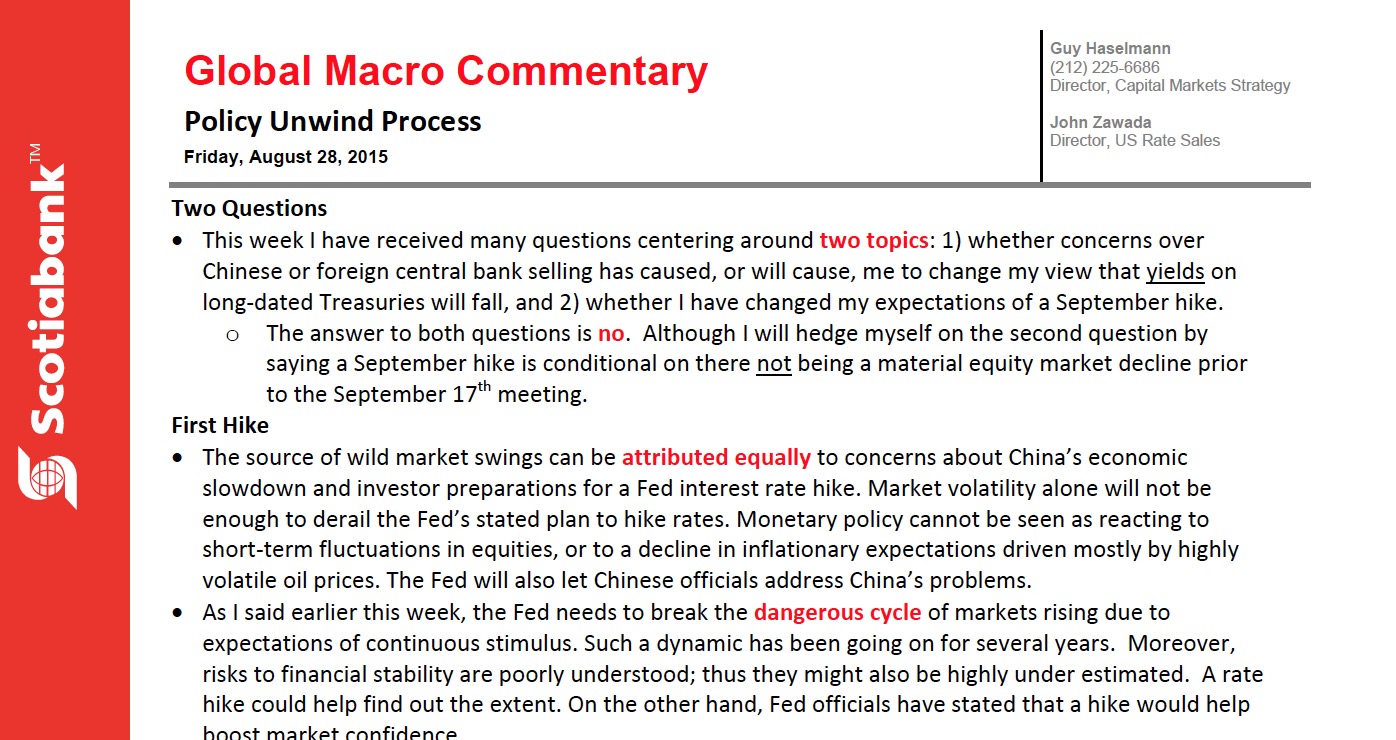Policy Unwind Process
by Guy Haselmann, Director, Capital Markets Strategy, Scotiabank GBM
Two Questions
• This week I have received many questions centering around two topics: 1) whether concerns over Chinese or foreign central bank selling has caused, or will cause, me to change my view that yields on long-dated Treasuries will fall, and 2) whether I have changed my expectations of a September hike.
o The answer to both questions is no. Although I will hedge myself on the second question by saying a September hike is conditional on there not being a material equity market decline prior to the September 17th meeting.
First Hike
• The source of wild market swings can be attributed equally to concerns about China’s economic slowdown and investor preparations for a Fed interest rate hike. Market volatility alone will not be enough to derail the Fed’s stated plan to hike rates. Monetary policy cannot be seen as reacting to short-term fluctuations in equities, or to a decline in inflationary expectations driven mostly by highly volatile oil prices. The Fed will also let Chinese officials address China’s problems.
• As I said earlier this week, the Fed needs to break the dangerous cycle of markets rising due to expectations of continuous stimulus. Such a dynamic has been going on for several years. Moreover, risks to financial stability are poorly understood; thus they might also be highly under estimated. A rate hike could help find out the extent. On the other hand, Fed officials have stated that a hike would help boost market confidence.
• Either way, the Fed should hike in September. The Fed will have plenty of economic cover to do so. Markets are likely to remain volatile, but it would be wise if the FOMC looked-through that volatility to avoid looking as if markets panicked them to pause. Markets have been adequately warned about a hike. Since the Fed has backed away from their guidance several times before, its credibility could be damaged by doing so again. Stan Fischer seemed to hint today of his preference for a September hike.
Treasuries and Central Bank Holdings
• While Fed custody holdings on behalf of foreign official accounts did not fall in the latest week, it is still possible that central banks sold outside the Fed system. Those details will show up in the Treasury’s TIC data which is ironically set for release on September 16th. I believe Treasury yields will be lower over the next few months regardless of how much selling has taken place.
• During the 97/98 SE Asian currency crisis, many central banks sold Treasuries to use FX reserves to support their sinking currencies. Treasuries were volatile but were still able to work their way to lower yields. The biggest drop happened after the IMF granted loan programs and the crisis seem to stabilize.
• In the following year, oil dropped to $11 per barrel triggering a Russian default and another lurch lower in Treasury yields. While central banks today are likely selling, the reasons behind those sales are the same which would cause other investors to step in and buy. Central bank selling of this type is temporary, yet the underlying catalysts are longer lasting and thus supportive for Treasury prices.
A Hypothetical Game
• Many are asking why the Fed has not yet raised rates. Interest rates remain at the emergency level of near-zero percent, but the US economy and financial markets arguably exited emergency conditions in 2010 or thereabouts. In addition, employment today is characterized by the FOMC as “nearly at full employment” and inflation has been stable and characterized as “mostly balanced”. With such enormous cumulative progress made on the economic front, and the Fed saying it is both data dependent and forward-looking, the argument could easily be made for a hike (not to mention a much higher Fed Funds target).
• Is it possible that FOMC members believe a 0.25% hike will derail the economy? Unlikely. Enough said.
• Is it possible that FOMC members believe that the first hike in 9 years could cause a major market correction? They have indicated that they expect “bumpiness”, but many have stated that they do not believe that a market correction will impact the broader economy in a meaningful way.
• Is it possible that FOMC members believe that rates cannot be lifted successfully due to $2.6 trillion of excess reserves in the banking system? This is unlikely since IOER and the Reverse Repo Facility have been tested so extensively. It will likely work the way they suspect. However, its imprecision is the reason for targeting a range.
• Is it possible that FOMC members fear economic problems in Asia or Europe? They probably have concerns, but they have stated that their policies are driven foremost by domestic factors. The real and troubling economic slowdown in China is rightly a major concern, but understanding the eventual impact on the US economy is impossible to know with any degree of accuracy.
• Is it possible that FOMC members are concerned about political pressures? Could these political pressures ultimately affect how the Fed removes accommodation? Yes. Now we are on to something.
• The Fed’s new and main policy tool is the interest that it pays on excess reserves (IOER). Paying interest helps the Fed control where the $2.5 trillion of reserves ends up. When IOER increases from 0.25% to 0.50%, the Fed’s payment to banks will rise from around $10 billion per year to around $20 billion per year.
• If the Fed is able to achieve their goal of ‘normalizing’ rates over the next several years, it would suggest an interest payment closer to 3.00%. Do the math on 3% of $2.6 trillion and you can clearly see why political troubles could arise for the Fed as the IOER begins to rise. The amount of interest is effectively what taxpayers pay to banks, because what the Fed doesn’t pay out gets remitted back to the US Treasury.
• Can you imagine a politician asking Janet Yellen how much taxpayers are paying to banks, many of which are foreign banks? Now image the answer being over $100 billion. This may be one reason why the Fed has not raised rates. However, it may also be why the Fed may wish to hike in September. Yes, it is confusing. It is also why the Fed can comfortably say that the pace will be gradual. Let me explain.
• If the Fed desires to remove accommodation in 2016 and/or 2017, they have a choice as to how to do it. Since Treasuries begin maturing from its balance sheet in 2016 ($210 billion), the Fed could let their balance sheet shrink instead of raising the IOER. A shrinking balance sheet is a defacto tightening.
• In theory, the Fed could do either. However, it might be more practical, and aesthetically and politically more appealing, to use the balance sheet tool, particularly after the IOER has begun to move higher.
• Shrinking the balance sheet without spooking financial markets will be tricky. Thus I expect it to be done as smoothly and carefully as possible. Either way, the Fed will be as ‘gradual’ as they are promising. However, this may not be as bullish for risk assets as markets want to believe. Looking at a chart of the positive correlation between the size of the Fed’s balance sheet and the performance of the S&P 500 says it all
“It is always wise to look ahead, but difficult to look further than you can see.” – Winston Churchill
Regards,
Guy
Guy Haselmann | Capital Markets Strategy
▬▬▬▬▬▬▬▬▬▬▬▬▬▬▬▬▬▬▬▬▬▬▬▬▬▬▬
Scotiabank | Global Banking and Markets
250 Vesey Street | New York, NY 10281
T-212.225.6686 | C-917-325-5816
guy.haselmann@scotiabank.com
Scotiabank is a business name used by The Bank of Nova Scotia
Copyright © Guy Haselmann, Director, Capital Markets Strategy, Scotiabank GBM
Global Macro Commentary August 28-Policy Unwind Process















